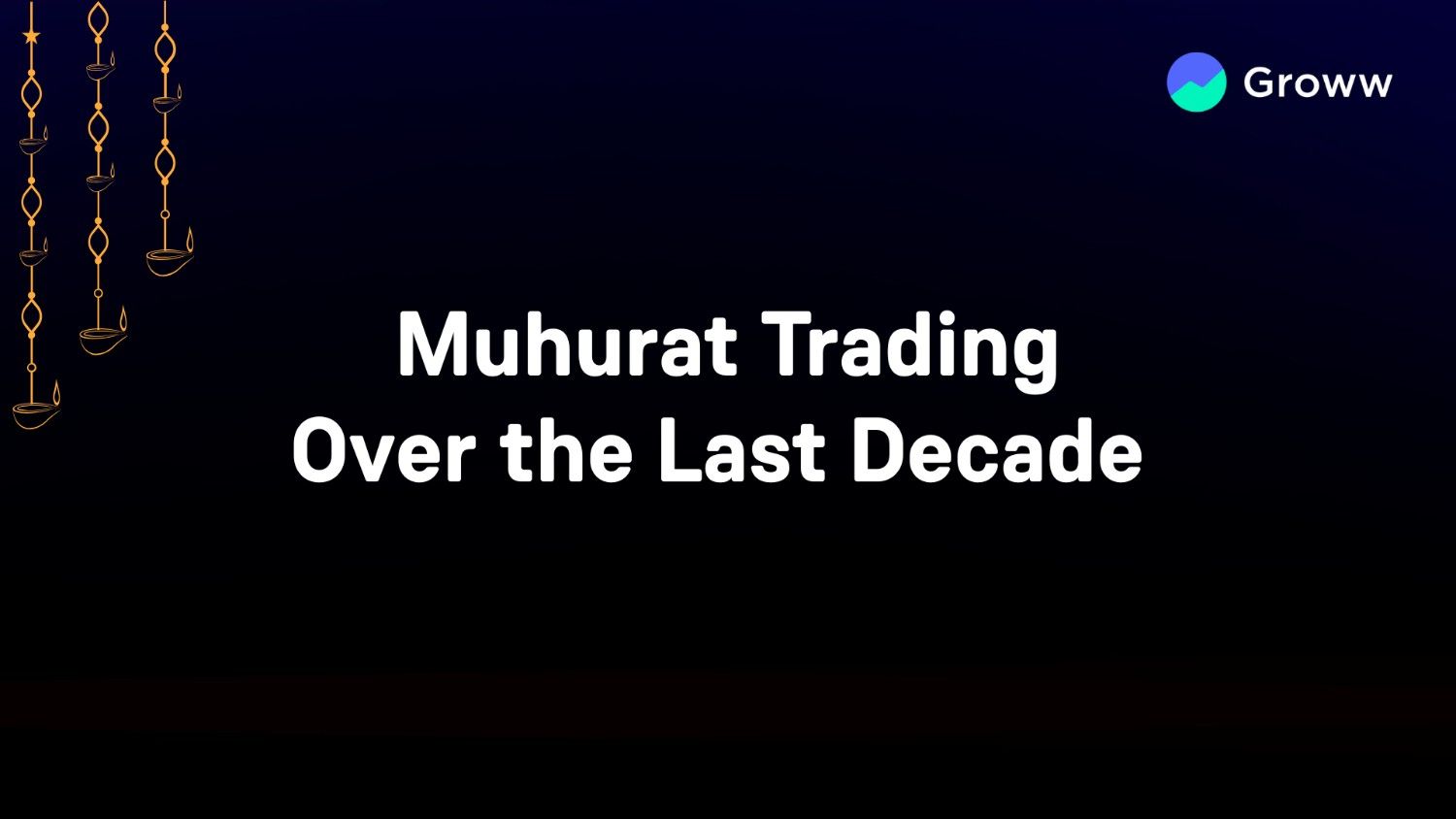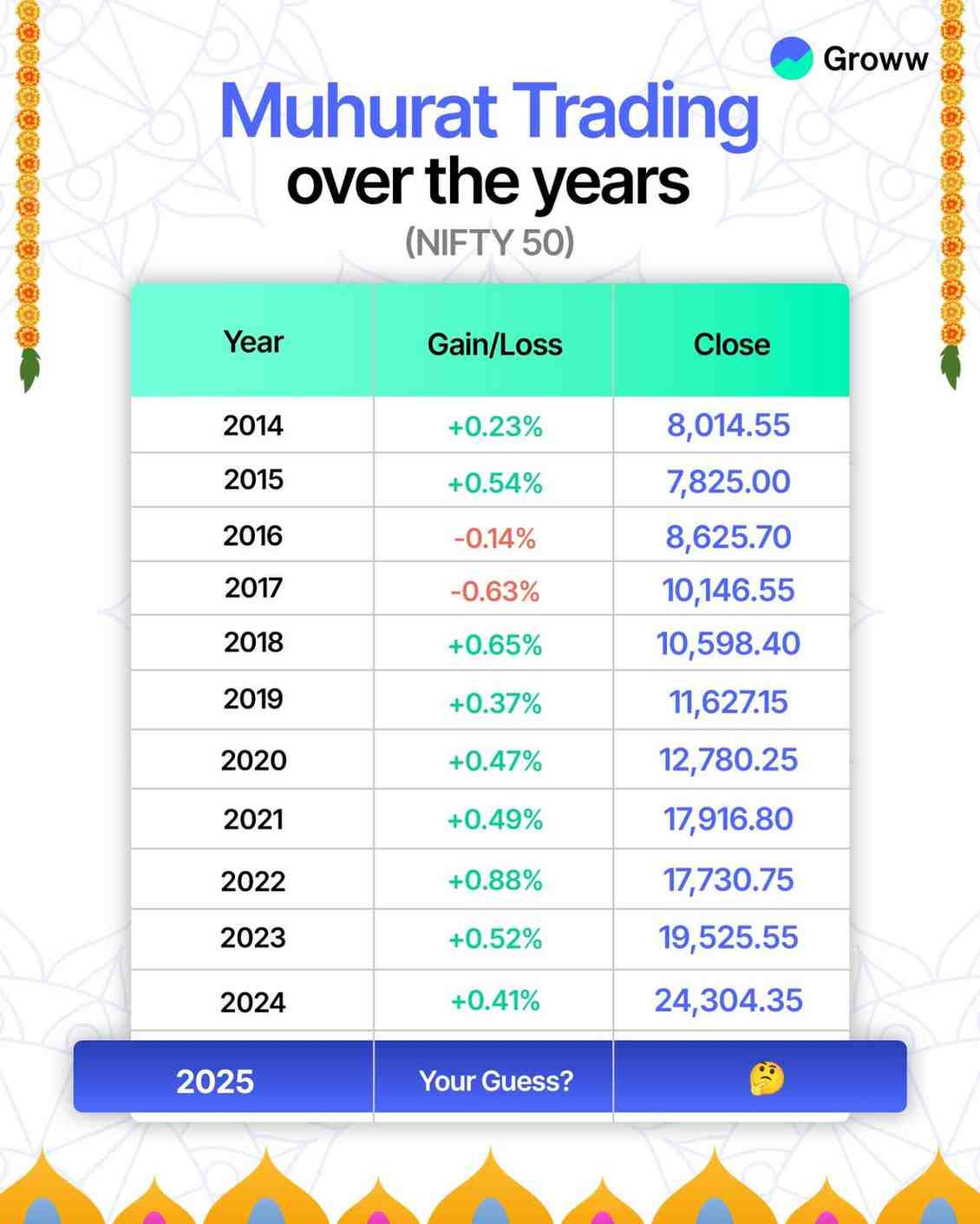Muhurat Trading Over the Last Decade - Key Trends & Historical Insights

Diwali is on the horizon, and it’s time for the Muhurat Trading session to commence. The date in 2025 is 21st October (the day of Diwali & Lakshmi Puja). Markets will remain closed for the day, with the exception of the special window. The key timings are the following:
- Normal market - 1.45-2.45 PM
- Pre-Open - 1.30-1.45 PM
- Block Deals - 1.15-1.30 PM
- Closing - 2.55-3.05 PM
- Trade Modification Cut-Off - 2.55-3.05 PM
This year, the main difference is that trading will be done in the afternoon slot, in place of the usual evening session. While you are gearing up to participate in Muhurat trading, here are some key trends and insights over the last decade that you may find helpful.
Muhurat Trading Performance Over the Last Decade
Here is a glimpse into the Muhurat Trading performance of the markets over the last decade.

Sectoral Trends for Muhurat Trading Over the Last Decade
Which sectors did well during Muhurat trading in the last decade? Here are some key insights worth noting.
|
Year |
Top Sectors |
|---|---|
|
2024 |
Auto, Metals/Energy, Banking |
|
2023 |
PSU, Small Caps |
|
2022 |
Banking & Financials, Auto, IT |
|
2021 |
Auto, PSU Banking |
|
2020 |
IT, Pharma, Metals |
|
2019 |
Auto, Industrials, Metals |
|
2018 |
Auto, Oil & Gas, FMCG, IT |
|
2017 |
Telecom |
|
2016 |
Mid & Small Caps (broader market), Select Financials |
|
2015 |
Realty, Capital Goods, Healthcare |
Last 10 Years Muhurat Trading- Fascinating Insights Worth Knowing
Here are some insightful factors and trends that are worth knowing before you participate in the 2025 Muhurat Trading session.
- These one-hour auspicious Diwali sessions were majorly positive between 2015 and 2024.
- 2023 saw the index gaining more than 0.5%, while 2022 saw massive growth of 0.8%+, with markets favorably responding to various economic indicators back then.
- The 2021 and 2020 sessions saw moderate gains hovering near the 0.5% mark, while 2019 was muted in comparison.
- 2018 was strong, with 0.65% growth, although 2017 and 2016 were the only two years when the markets did not perform positively. In contrast, 2015 closed firmly with an uptick of close to 0.5%.
- 2020 was a challenging year, with the index grappling with concerns related to the global pandemic. Yet, its positive performance was a testament to overall market resilience at the time.
- When calculating based on the overall patterns, Muhurat Trading sessions have usually generated average returns of about 0.53% in the last decade. This consistency is something that stands out when you consider how volatile markets remained throughout all these years.
- Some attribute this to the positive and cultural optimism that surrounds Diwali and Lakshmi Puja.
- The average also outstrips the usual hourly returns seen during standard trading days. Thus, the probability of positive returns is 80%, since 8 out of 10 sessions closed with positive returns.
- Standard deviation throughout the returns is also comparatively lower at approximately 0.15%. This indicates that while the returns are primarily positive, they also deviate rarely from the average in a dramatic fashion.
- Hence, Muhurat Trading is more predictable. This makes it more attractive to all investors who want comparatively stable opportunities to begin the symbolic Hindu financial year.
Understanding Market Sentiments and Other Key Factors Surrounding Muhurat Trading
Now that you’ve seen the facts and figures, it’s time to dive deeper into the psychology driving market sentiments during Muhurat Trading. There are several fascinating insights that crop up in this regard.
- The core essence of Muhurat Trading goes beyond mere movements in the market. It is representative of a unique combination of festivity, optimism, finance, and belief.
- This mix has shaped the participation of investors and their behaviour for several generations to date.
- Hence, unlike any other standard trading session, this one has a lot of psychological and spiritual significance for every participant.
- The tradition of Muhurat Trading derives primarily from the Hindu faith and tenets revolving around the auspicious timings. The Muhurat term itself indicates a lucky and favourable time for beginning something new financially.
- This practice also symbolises the start of the new financial year, especially for the traditional trading communities like Marwaris and Gujaratis.
- Many families also worship Lakshmi, the Goddess of Wealth, before lighting Diyas, and then placing their trades. Hence, the Muhurat Trading session is rooted in ceremonial and spiritual significance. Many believe that putting a market trade at this time ushers in financial success and prosperity for the coming year.
Some Other Standard Associations of Muhurat Trading
Muhurat Trading in India is also associated with several other happenings/developments. Some of them include:
- The participation of retail investors increases exponentially during the Muhurat Trading sessions as compared to standard trading days.
- There is huge participation from not only experienced investors, but also retail traders who enter the market only to make token purchases at this perceived lucky time.
- Different regional practices also influence the approach taken by investors. For example, in North India, traders usually visit temples before making trades. Gujarat and Maharashtra hold festive celebrations at the exchanges and carry out special trading rituals.
- Eastern India is more about holding the Pancha-upachara puja before trading, while Southern India tweaks the timings based on specific astronomical calculations.
- Investors diversify their portfolios with smaller investments throughout various sectors, while engaging more with the market rituals. Also, it builds a community feeling that encourages higher market participation.
- Several financial institutions also understand the cultural importance of this market tradition. Many of them offer special offers and incentives for investor participation during this time.
- Experts usually feel that benchmark indices mostly witness positive growth at the time of Muhurat Trading, with the Nifty and Sensex expected to close positively. This is something that syncs with a broader consensus- short-term market surges are a product of collective optimism.
- Brokerages usually offer targeted advice and recommendations for investors based on market conditions just ahead of the Muhurat Trading session.
- Yet, going by the statistics mentioned above, it’s clear that positive and ceremonial occasions do not always translate into growth. There were two years of negative growth, i.e. 2016 and 2017.
- One fascinating insight in this regard is that the Nifty often forms a daily red candle at the time of the Muhurat session. This pattern has been so consistent that many traders have created selling strategies for the opening and covering positions by the close of the session. This strategy may have been more profitable across several years.
- Negative performance may arise from broader market pressure and scenarios where FIIs (foreign institutional investors) make considerable sell-offs.
What Else to Learn from Muhurat Trading Trends for the Last 10 Years
Here are some other inputs to be taken from Muhurat trading trends over the last decade.
- You should approach the ceremonial trading window cautiously, since Muhurat sessions may witness higher volatility than regular trading days at times.
- Banking and financial stocks have typically led the pack in terms of gains, usually based on expectations of festive credit demand.
- Auto sectors have shown resilience and strong gains over the years, while the same story is true for PSU banks.
- IT, metals, and pharma have also been stellar performers, although their performance may be affected more by global factors.
- In 2024, for instance, almost all sectoral indices closed positively. This was an indicator of healthy market breadth and broad-based investor optimism.
- When it comes to steady winners, banking and IT have dominated the last few years, with large-cap heavyweight names like HDFC Bank and Reliance usually doing well.
- Cash segment turnover during the 2024 session touched ₹18,224.98 crore and ₹2,073.05 crore on the NSE and BSE, respectively. This indicates higher investor participation in the market, with many people using these sessions to make symbolic investments.
- They often prefer long-term and blue-chip stocks, setting up positions that they often hold for several years. Hence, a large chunk of investors in the trading window are not those looking for short-term gains only.
Conclusion
As you can see, Muhurat Trading is a highly auspicious and ceremonial market ritual that signals the start of the Hindu financial year. This is why it is crucial for traditional trading communities and seasoned/new investors alike. The remarkable nature of the trading session is evident when you consider how it has an 80% probability rate of positive growth in the last decade. This happens with only a single trading session in place of an entire day’s trading. Hence, it can be regarded as a harbinger of higher investor participation in the market as well.
While the positive trends and optimism augur well for investing during this time, it’s always important to do your homework before investing. Make sure your investment adds value to your portfolio and syncs with your future financial goals. Here’s wishing you a prosperous and enjoyable Muhurat Trading session ahead in 2025!